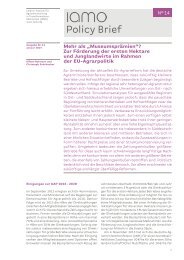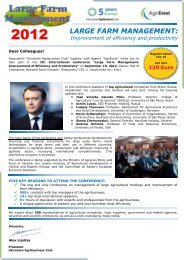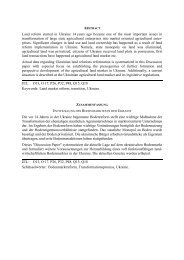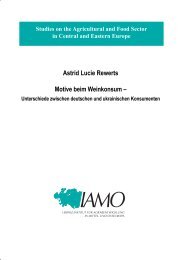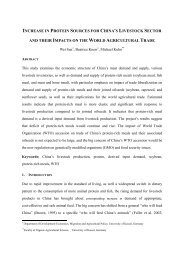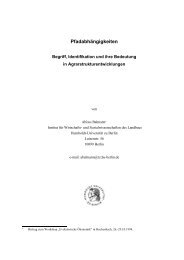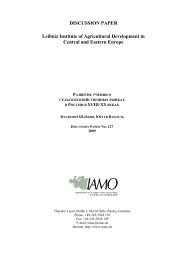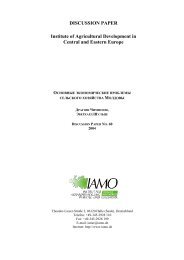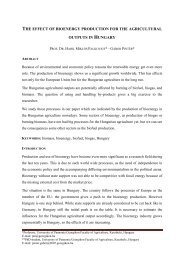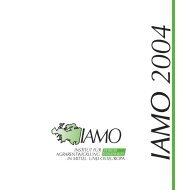Abstract - IAMO
Abstract - IAMO
Abstract - IAMO
Create successful ePaper yourself
Turn your PDF publications into a flip-book with our unique Google optimized e-Paper software.
16 ANDREAS WILDERMUTH<br />
to mitigate losses (WINTER 1992, pp. 61-62). If this is the case, the optimal insurance contract<br />
invariably deviates from a symmetric-information first-best contract, thus causing a welfare<br />
loss. If e.g. the symmetric-information first-best contract between a risk-neutral insurer and a<br />
risk-averse insured involves full insurance, a second-best solution will entail some kind of<br />
risk-sharing leading to a welfare loss. Under certain circumstances this risk-sharing can take<br />
the form of a deductible or an upper limit on indemnities, but for the general case it is difficult<br />
to derive properties of the indemnity schedule that hold in all possible cases (WINTER 1992,<br />
pp. 71-78, 88-91; SCHÖNFELDER 1986, pp. 230-235; GROSSMAN and HART 1983). This<br />
deviation from the symmetric-information first-best solution entails a social welfare loss<br />
which can be so high that in the presence of transaction costs the gains from trade from<br />
insurance vanish and the risk becomes uninsurable. According to SCHÖNFELDER (1986,<br />
pp. 234-235) this market failure can justify the subsidisation of monitoring activities because<br />
their social benefits in terms of welfare gains can exceed their private benefit to the insurer<br />
whose additional profit might be bid away by a competitor. This argument holds, but it should<br />
be noted that it is only an argument for a particular kind of transaction cost subsidy, not for<br />
large-scale subsidisation of operating costs and premiums as in the United States, where the<br />
states bears all operating costs and grants subsidies of up to 30% of net risk premiums<br />
(GARDNER 1994, p. 30; KNIGHT and COBLE, 1997, p. 130).<br />
But the availability of on-farm risk management tools can have another effect. If they are<br />
efficient enough they can make crop insurance superfluous, in the sense that even for a riskneutral<br />
insurer it is impossible to find a collective of farmers to whom he can offer insurance<br />
contracts that will make them better off and at least cover his opportunity cost. This is the<br />
central point of the second line of argument and has been elaborated in detail by WRIGHT<br />
and HEWITT (1994). These authors argue that theoretical models, which explicitly or implicitly<br />
assume that multiple-peril crop insurance, all-risk crop insurance or revenue insurance 4 are the<br />
only available risk-management tools, greatly overstate the benefits of these types of<br />
insurance. These models neglect the elementary fact that insurance is only one riskmanagement<br />
tool among many; i.e. the benefits and costs of insurance have to be weighed<br />
against the costs and benefits of on-farm risk-management tools (spatial diversification, crop<br />
diversification, loss-reduction technologies like irrigation, off-farm employment in the case of<br />
a family farm, and intertemporal financial smoothing. The latter means that an agricultural<br />
enterprise or a farmer varies savings and uses the credit market to reduce the impact of income<br />
fluctuations (WRIGHT and HEWITT 1994, pp. 90-95). Therefore, the authors propose the<br />
following thesis (1994, p. 95):<br />
„If insurance offered on competitive terms (recognising the true opportunity cost of resources) by private and<br />
public insurers is accepted by farmers, then such insurance may be socially valuable, unless it exacerbates other<br />
sources of market failure such as environmental externalities. Its value is not, however, the full value (net of<br />
costs) of the smoothing of consumption achieved by insurance, but the value relative to what could be achieved<br />
in the absence of insurance. When farmers don’t buy insurance on competitive terms, the simplest inference is<br />
that this value is negative.“<br />
Therefore, according to these authors, the reason for the non-existence of unsubsidised<br />
multiple-peril crop insurance is simply that „multiple-peril crop insurance is worth less than it<br />
costs, if full costs are covered by premiums in the long run“ (WRIGHT and HEWITT 1994,<br />
p. 88). They provide evidence from studies on the US multiple-peril crop insurance<br />
programme to support their thesis. For details the reader is referred to their paper; in our paper<br />
4 Revenue insurance simultaneously insures yield and output price risk.



